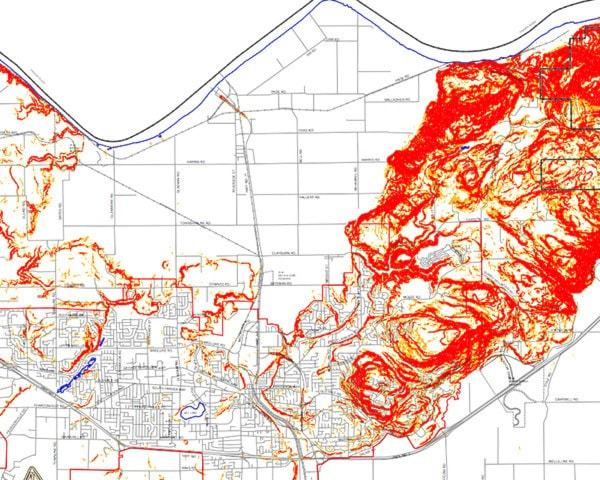Sumas Mountain property owners say they are worried the City of Abbotsford’s new Official Community Plan will dramatically curb their ability to use their land.
But the city says such fears are overblown and that the new plan – which has yet to be adopted by council – will see few changes from the current rules in place.
More than 100 residents packed into Straiton Hall Tuesday evening to voice their concerns about the proposed plan and hear from the city.
Trevor Newton, with the Sumas Mountain Rural Property Owners Association, said residents are concerned that the new plan will increase the red tape owners must navigate to build even small structures on properties located in what was Fraser Valley Regional District’s Area H before it was absorbed by the city in 2008.
And he said the current concerns aggravate long-standing issues between Sumas Mountain residents and city hall dating back years.
“A lot of people up here are really frustrated, and I think they walked away from the meeting more frustrated than they walked in.”
City manager George Murray attended the meeting, and noted the OCP is still in its consultation stage and that he has relayed the concerns to planning staff. Council has the final say on the adoption of the new OCP.
“We are looking at it and how to best address it,” he said.
At the core of the residents’ concerns are policies contained within the draft Official Community Plan relating to environmentally sensitive areas and those areas with steep slopes exceeding 20 per cent.
Newton says those regulations dramatically increase the likelihood rural property owners will have to get a geotechnical report done on their entire property.
Previously, he said such studies would be ordered after a site visit and limited to the portion of the property with steep slopes.
Newton said there are also concerns that the language regarding environmentally sensitive areas could be interpreted in such a way as to prevent nearly all construction on mountain properties.
“This is a dramatic encroachment and increase of the resources that are necessary to get any permit at all.”
Newton said residents also felt “betrayed” because, after raising opposition to the proposed Sumas Mountain Environment Management Plan in 2012, they had been promised by then-mayor Bruce Banman that the Area H OCP currently in place for much of rural Sumas Mountain would be maintained, with “a few tweaks.”
Mark Neill, the city’s director of community planning, said the current plan “does not materially change” regulations surrounding land use on Sumas Mountain, although the permit process will go through the city now, as opposed to the Fraser Valley Regional District, which previously issued permits for the area.
“There are some subtle changes,” he said.
The steep-slope guidelines will now be triggered when slopes reach 20 per cent, as opposed to a previous system based on risk-based mapping and through evaluations of an inspector.
“It will be similar to the process that is used in other parts of Sumas Mountain and Vedder Mountain,” he said.
“That doesn’t say you can’t develop, or build a house, it’s simply saying a development permit is triggered to ensure that intended use is constructed or built in a responsible way.”
As for the sense of betrayal, Murray added that city politicians and staffers cannot promise which policies and bylaws will be adopted by future elected councils.
He also chafed at suggestions the public wasn’t given a chance to provide their input, pointing to a consultation process that has taken more than a year.
“This is probably the broadest public OCP consultation process I’ve ever been involved in, in 31 years,” he said.
